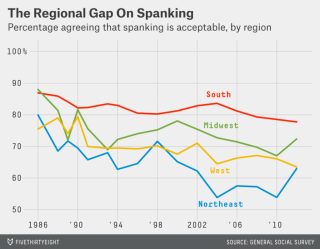Punishment
Discipline Tips to Avoid Spanking: Hitting Doesn’t Help
Evidence on spanking and effective tips to change behavior
Posted September 20, 2014

Decades of research have been conducted on the negative effects of spanking and corporal punishment on children. However, many parents continue to use spanking to discipline their child. In the wake of the abuse allegations that have been in the media do to Adrian Petterson, NFL player for the Minnesota Vikings may are discussing if spanking should be allowed.
Recently, an article suggested that given studies on spanking the US should ban it. According to Dan Arel, author of Parenting Without God, religion has a lot to do with why many continue to use spanking. Arel states that, “many religious groups condone and endorse corporal punishment techniques”. As a child psychologist, I have worked with many parents who use spanking to discipline their child. For those parents who use spanking and physical punishment, their goal is to decrease bad or problem behavior. However, long-term spanking typically increases aggressive behavior in children.
When Does Physical Punishment Become Abuse?
According the U.S. Department of Health and Human Services, physical abuse is injury as a result of punching, beating, hitting (with a hand, strap, or object) or harming a child. Furthermore, abuse does not include spanking or physical discipline as long as it is reasonable and causes no bodily injury to the child. In an interview by the American Psychological Association (APA, 2010), Dr. Alan Kazdin states that even moderate-to-severe physical punishment can have long-term negative consequences for the child such as poor academic performance, mental and physical health. Given these concerns it is important to use alternative ways to discipline your child.
Signs that may indicate abuse among children
- Has unexplained burns, bites, bruises, broken bones, or black eyes
- Has fading bruises or other marks noticeable after an absence from school
- Seems frightened of the parents and protests or cries when it is time to go home
- Shrinks at the approach of adults
- Reports injury by a parent or another adult caregiver
- Abuses animals or pets
Effective Discipline Strategies 

Effective Discipline Strategies
Spanking and physical punishment are not effective ways to discipline your child. This is supported by years of research. According to a study published in Developmental Psychology, spanking is less effective for changing behavior and parental warmth does not appear to decrease the negative effects that spanking have on child development (see Lee, Altschul, & Gershoff, 2013). Below are a few suggestions to improve your child’s behavior.
- Use positive reinforcement: Children greatly benefit from positive attention and praise of good or desired behavior. For example if your child has a problem with aggressive behavior, use positive reinforcement (such as verbal praise or rewards) when the child engages in non-aggressive behavior.
- Consistently use consequences: Although no one is perfect, many parents do always follow their own rules. If you have a rule or consequence for inappropriate behavior always enforce it. The more children know that there is no chance of “getting away with something” they are more likely to not engage in undesired behavior.
- Take feedback from your child: When creating rewards for desired behavior or coming up with punishment get input from your child. Often rewards or punishment don’t work because they seem important to you as a parent but they’re not to the child. By getting input from your child it increases the likelihood that the reward or consequence will motivate the child to change their behavior.
For more helpful suggestions, please visit the resource page on my website. If you feel that you need professional help, the APA and National Register of Health Service Psychologists provide a resource for locating a professional in your area.
© 2014 Erlanger A. Turner, Ph.D.
Be sure to follow me on Twitter (www.twitter.com/drearlturner) and Facebook (www.facebook.com/DrEarlTurner). Join the conversation and discuss other topics related to parenting, mental health, wellness, and psychology.
References:
Child Welfare Information Gateway. (2013). What is child abuse and neglect? Recognizing the signs and symptoms. Washington, DC: U.S. Department of Health and Human Services, Children’s Bureau. Retrieved from https://www.childwelfare.gov/pubs/factsheets/whatiscan.cfm
Lee,S.J., Altschul, I, & Gershoff, E. T. (2013). Does warmth moderate longitudinal associations between maternal spanking and child aggression in early childhood? Developmental Psychology, 49, 11, 2017-2028. doi: 10.1037/a0031630
Image via Atlanta Black Star


